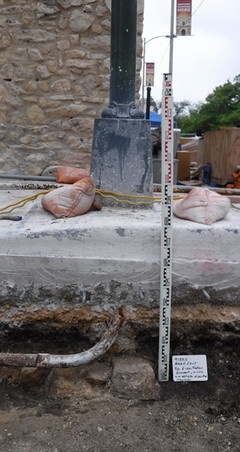After a backhoe was used to remove layers of road base and some previously disturbed soils for the installation of the safety bollards on the north side of the Plaza, a conduit was revealed coming from one of the traffic lights at the corner of the street. The conduit was encased in concrete. The concrete was removed to allow the engineers to determine more information concerning the location of the conduit and the impact it would have on the positioning of the bollards. Once the concrete was removed, it became apparent that the conduit was in the way of the bollard installation. The concrete removal around the conduit also revealed an exciting feature.
Behind and under a small segment of the conduit, under the currently installed traffic light, a portion of a limestone foundation was revealed in the profile of the trench. Clearing the concrete from the conduit revealed this feature, as it would not have been observed otherwise: the concrete encasing the conduit had obstructed the view of the foundation.
This is an exciting feature because the possible foundation is in line with the west wall of the Long Barrack. Researchers have speculated that another structure, or a continuation of the existing structure, was present north of the Long Barrack. Previous archaeological investigations have not been conducted in alignment with the Long Barrack walls north of the current standing structure.



